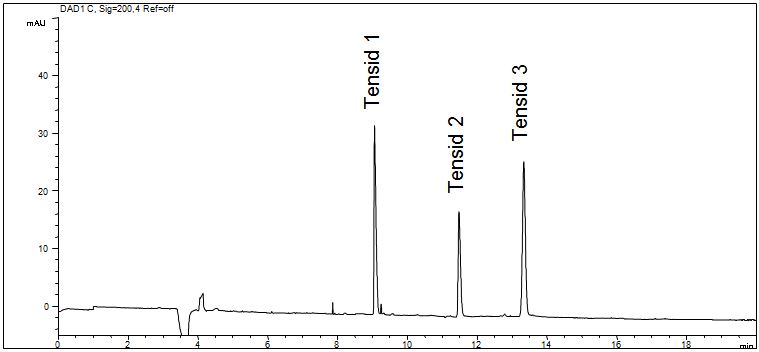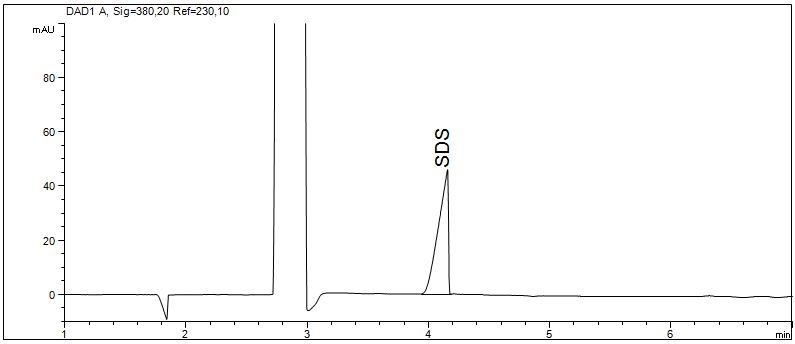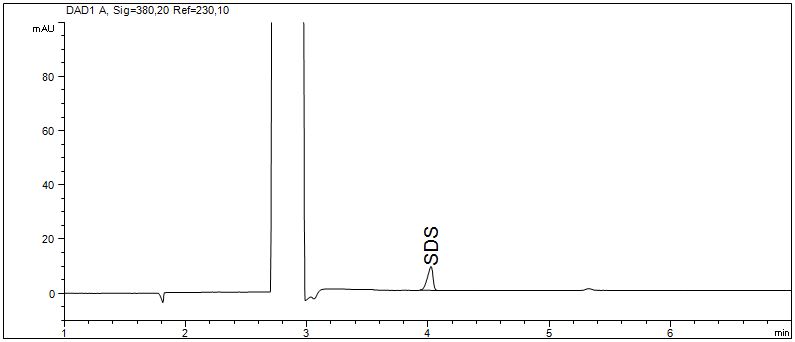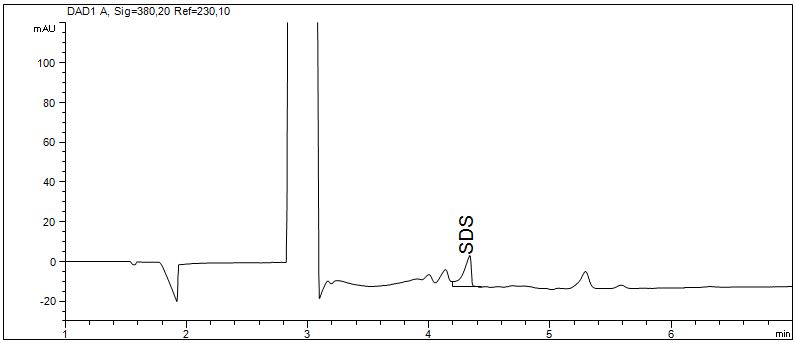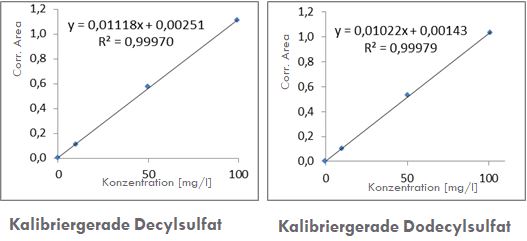Key words: surfactants, Tenside, CE, SDS, CPC, CTA, CHX
The determination of ionic surfactants with chromophoric groups as well as surfactants that do not absorb UV radiation can be achieved with capillary electrophoresis. For direct UV detection the use of MEKC is preferred due to the suppression of the interactions of the analytes with the wall of the capillary. The determination of anionic surfactants with indirect UV detection is done without modifier. The surfactant migrates as a slow anion after the EOF signal (as shown for SDS).
Many surfactants are also known to destroy the lipid envelope of viruses due to their surface-active effect. Two well-known cationic representatives are cetylpyridinium chloride (CPC) and chlorhexidine (CHX), which are already freely available in many products such as mouthwashes, lozenges, throat sprays and toothpastes.
Anionic surfactants with direct UV-detection
- Separation: MEKC
- Electrolyte: Borate-SDS
- Capillary: Bubble Cell, fused silica, 50 µm ID, 64 cm in total
- Detection: direct UV, 200 nm
- Description: The standard solution contains three anionic surfactants with chromophoric group, 20 mg/l each.
Download: Tenside_1.pdf
SDS with indirect UV-detektion, Standard solution 100 mg/l
- Separation: CZE
- Electrolyte: Salicylate
- Capillary: fused silica, 75 µm ID, 64 cm in total
- Detection: indirect UV, 230 nm
- Description: The standard solution contains 100 mg/l SDS.
Download: Tenside_2.pdf
SDS with indirect UV-detektion, standard solution 10 mg/l
- Separation: CZE
- Electrolyte: Salicylate
- Capillary: fused silica, 75 µm ID, 64 cm in total
- Detection: indirect UV, 230 nm
- Description: The standard solution contains 10 mg/l SDS.
Download: Tenside_3.pdf
SDS in shampoo
- Separation: CZE
- Electrolyte: Salicylate
- Capillary: fused silica, 75 µm ID, 64 cm in total
- Detection: indirect UV, 230 nm
- Description: The shampoo was diluted thousandfold.
Download: Tenside_4.pdf
SDS in buffer solution
- Separation: CZE
- Electrolyte: Salicylate
- Capillary: fused silica, 75 µm ID, 64 cm in total
- Detection: indirect UV, 230 nm
- Description: The buffer was diluted 1: 500.
Download: Tenside_5.pdf
Separation of decylsulfate and dodecylsulfate
- Separation: CZE
- Electrolyte: Salicylic acid, Tris
- Capillary: fused silica, 75 µm ID, 64 cm in total
- Detection: indirect UV, 230 nm
- Description: The separation of decyl- and dodecylsulfate is possible. The LOD is about 1 mg/l.
Download: Decylsulfat-Dodecylsulfat.pdf
Cationic aromatic surfactants: N-Hexadecylpyridinium chloride (CPC)
Synonyms: n-Cetylpyridinium chloride, CPC, CAS: 123-03-5
N-Cetylpyridiniumchlorid (CPC) represents a quarternary ammonium compound. In contrast to SDS, CPC it is a cationic surfactant. In acidic surrounding (pH=2,5) CPC can be determined as cation. In the following example micelles of SDS of the buffer solution form mixed micelles with CPC, therefore changing CPC into an anionic form. Due to its high UV absorption CPC can be determined with direct UV detection
CPC is used as preservative and is added to pills against sore throats, toothepaste and mouth wash due to its antiseptic property.
- Separation: MEKC
- Electrolyte: Borate-SDS
- Capillary: fused silica, 50 µm ID, bubble cell, 48 cm in total
- Detection: direct UV, 254 nm
- Description: The aqueous standard solution contains 100 mg/l CPC. The UV spectrum is shown at the maximum of the peak.
Download: Standard-CPC-Spektrum.pdf
Analysis of N-cetylpyridiniumchloride (CPC) in an analgesic for sore throats
- Separation: MEKC
- Electrolyte: Borate-SDS
- Capillary: fused silica, 50 µm ID, bubble cell, 48 cm in total
- Detection: direct UV, 254 nm
- Description: For sample preparation one tablet was dissolved in 10 ml pure water.
Download: CPC-Halsschmerztablette.pdf
Calibration of N-cetylpyridiniumchloride (CPC)
- Separation: MEKC, short-end
- Electrolyte: Borate-SDS
- Capillary: fused silica, 50 µm ID, bubble cell, 48 cm in total
- Detection: direct UV, 254 nm
- Description: The calibration of CPC was investigated in the concentration range from 5 mg/l to 200 mg/. For these determinations the short-end injection was applied. In the PDF some selected electropherograms and the calibration graph are shown.
Download: CPC-calibration.pdf
CPC in Mouth rinsing solution
- Separation: MEKC, short-end
- Electrolyte: Borate-SDS
- Capillary: fused silica, 50 µm ID, bubble cell, 48 cm in total
- Detection: direct UV, 200 nm and 254 nm
- Description: In addition to CPC, other sample components can also be analysed simultaneously. Since CPC is detectable at 254 nm as well as at 200 nm, the wavelength can be adjusted as needed for optimal detection of other ingredients.
Download: CPC-mouth-rinsing.pdf
CPC in Mouth sprays
- Separation: MEKC, short-end
- Electrolyte: Borate-SDS
- Capillary: fused silica, 50 µm ID, bubble cell, 48 cm in total
- Detection: direct UV, 200 nm
- Description: The two mouth sprays were diluted using pure water. In addition to CPC also Saccharin as well as Lidocaine can be investigated. In the PDF the electropherograms of two different mouth sprays are shown.
Download: CPC-mouth-spray.pdf
CPC in Throat tablets
- Separation: MEKC, short-end
- Electrolyte: Borate-SDS
- Capillary: fused silica, 50 µm ID, bubble cell, 48 cm in total
- Detection: direct UV, 200 nm and 254 nm
- Description: One tablet was dissolved in 20 ml water. In addition to CPC also Benzocaine can be determined. In the PDF the electropherograms at 200 nm and 254 nm can be seen.
Download: CPC-throat-tablet.pdf
Cationic aromatic surfactant: Chlorhexidine (CHX)
IUPAC: 1,1′-Hexamethylenbis[5-(4-chlorphenyl)biguanid], CAS: 55-56-1, C22H30Cl2N10
CHX is used as a bactericide for disinfection in the oral cavity. It is also used for wound healing in plasters, wound healing ointments and in powders. In current studies, CPC and CHX are taken into account to fight viruses in the oral cavity. This effect is based on the destruction of the lipid envelope of the viruses. Since the novel coronavirus also has a lipid envelope, CPC and CHX have come into focus as possible drugs to reduce the viral load in the throat.
- Separation: MEKC
- Electrolyte: Borate-SDS
- Capillary: fused silica, 50 µm ID, bubble cell, 48 cm in total
- Detection: direct UV, 254 nm
- Description: The aqueous standard solution contains 25 mg/l Chlorhexidine (CHX). The UV spectral data are shown at the maximum of the CHX peak. In the PDF the LOD and LOQ are summarized.
Download: CHX-standard.pdf
- Description: The calibration of Chlorhexidine (CHX) was investigated in the concentration range from 1 mg/l to 200 mg/l. The PDF shows selected electropherograms and the calibration graph.
Download: CHX-calibration.pdf
Chlorhexidine (CHX) in gargling solution and mouth rinsing solution
- Description: Chlorhexidine (CHX) was determined in gargling and mouth rinsing solutions. In the PDF the electropherograms of two solutions at 200 nm and 254 nm are summarized. Conditions as described above.
Download: CHX-gargling-solution.pdf
Aliphatic (linear) cationic tensids: DTA, TTA and CTA
In most cases linear cationic surfactants are quarternary ammonium cations, also known as “quats”. They show good solubility in water and are permanently charged independent of the pH value of the solution. They are widely used as disinfectants, in liquid fabric softeners and as antistatic agents in shampoos.
Dodecyltrimethylammonium- (DTA), tetradecyltrimethylammonium- (TTA) and cetyltrimethylammonium- cations (CTA) represent the homologue serie of quats with alkyl chains in the length of 12 to 16 carbon atoms.
DTA is also known as 1-dodecanaminium, N,N,N-trimethyl, lauryltrimethylammonium, FSM 23 or Morpan D.
Synonyms of TTA are N,N,N-trimethyl-1-tetradecanaminium, trimethylmyristylammonium, Morpan T, Mytab, Pentonium, Quaternium 13, Querton, Tetradonium or TDTMA.
CTA can also be found as hexadecyltrimethylammonium (HTA), N,N,N-trimethylhexadecyl-ammonium, N,N,N-trimethyl-1-hexadecanaminium, cetrimid (INN), cetrimonium , Acetoquat , Arquad 16/60, Cirrasol OD, HDTMA, HTA, Lauroseptol, Lissolamine, Micol, Pollacid, Quamonium, Rhodaquat M 242B99, Softex KW, Varisoft CTB 40, Centimide, Cetavlon, Cetarol, Cycloton V, Lissolamin V, Suticide or palmityltrimethylammonium .
- Separation mode: CZE
- Electrolyte: Aminobenzimidazole (ABI)
- Capillary: fused silica, 50 µm ID, 48 cm total
- Detection: indirect UV, 220 nm
- Description: Baseline separation of the three homologues is achieved using ABI as electrolyte. The detection in capillary electrophoresis is done in the indirect mode because the molecules do not have UV active functions.

Standard solution: DTA (Dodecyltrimethylammonium), TTA (Tetradecyltrimethylammonium) and CTA (cetyltrimethylammonium)
Download: DTA-TTA-CTA.pdf
Download: DTA-TTA-CTA2.pdf
Analysis of TBA (Tetra-n-butylammonium cation)
TBA (tetra-n-butylammonium cation) is also a quarternary ammonium cation (quat). TBA as bromide salt is often used in chemical synthesis and as a phase transfer catalyst.
- Separation mode: CZE
- Electrolyte: Aminobenzimidazole (ABI)
- Capillary: fused silica, 50 µm ID, 48 cm total
- Detection: indirect UV, 220 nm
- Description: The single standard solution of TBA is shown.
Download: TBA.pdf
